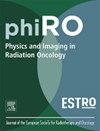Deep learning combining imaging, dose and clinical data for predicting bowel toxicity after pelvic radiotherapy
IF 3.3
Q2 ONCOLOGY
引用次数: 0
Abstract
Background and Purpose:
A comprehensive understanding of radiotherapy toxicity requires analysis of multimodal data. However, it is challenging to develop a model that can analyse both 3D imaging and clinical data simultaneously. In this study, a deep learning model is proposed for simultaneously analysing computed tomography scans, dose distributions, and clinical metadata to predict toxicity, and identify the impact of clinical risk factors and anatomical regions.
Materials and methods
: A deep model based on multiple instance learning with feature-level fusion and attention was developed. The study used a dataset of 313 patients treated with 3D conformal radiation therapy and volumetric modulated arc therapy, with heterogeneous cohorts varying in dose, volume, fractionation, concomitant therapies, and follow-up periods. The dataset included 3D computed tomography scans, planned dose distributions to the bowel cavity, and patient clinical data. The model was trained on patient-reported data on late bowel toxicity.
Results:
Results showed that the network can identify potential risk factors and critical anatomical regions. Analysis of clinical data jointly with imaging and dose for bowel urgency and faecal incontinence improved performance (area under receiver operating characteristic curve [AUC] of 88% and 78%, respectively) while best performance for diarrhoea was when analysing clinical features alone (68% AUC).
Conclusions:
Results demonstrated that feature-level fusion along with attention enables the network to analyse multimodal data. This method also provides explanations for each input’s contribution to the final result and detects spatial associations of toxicity.
结合影像学、剂量和临床数据的深度学习预测盆腔放疗后肠道毒性
背景与目的:全面了解放射治疗毒性需要对多模态数据进行分析。然而,开发一种能够同时分析3D成像和临床数据的模型是具有挑战性的。在本研究中,提出了一种深度学习模型,用于同时分析计算机断层扫描、剂量分布和临床元数据来预测毒性,并确定临床危险因素和解剖区域的影响。材料与方法:提出了一种基于特征级融合和注意力的多实例学习深度模型。该研究使用了313例接受三维适形放射治疗和体积调制电弧治疗的患者的数据集,这些患者在剂量、体积、分割、伴随治疗和随访期间都有不同的异质性队列。该数据集包括三维计算机断层扫描,计划到肠道的剂量分布和患者临床数据。该模型是根据患者报告的晚期肠毒性数据进行训练的。结果:神经网络可以识别潜在的危险因素和关键解剖区域。结合影像学和剂量分析临床资料,对肠急症和大便失禁可提高治疗效果(受试者工作特征曲线下面积[AUC]分别为88%和78%),而对腹泻的最佳治疗效果是单独分析临床特征时(AUC为68%)。结论:结果表明,特征级融合以及注意力使网络能够分析多模态数据。该方法还为每个输入对最终结果的贡献提供解释,并检测毒性的空间关联。
本文章由计算机程序翻译,如有差异,请以英文原文为准。
求助全文
约1分钟内获得全文
求助全文
来源期刊

Physics and Imaging in Radiation Oncology
Physics and Astronomy-Radiation
CiteScore
5.30
自引率
18.90%
发文量
93
审稿时长
6 weeks
 求助内容:
求助内容: 应助结果提醒方式:
应助结果提醒方式:


